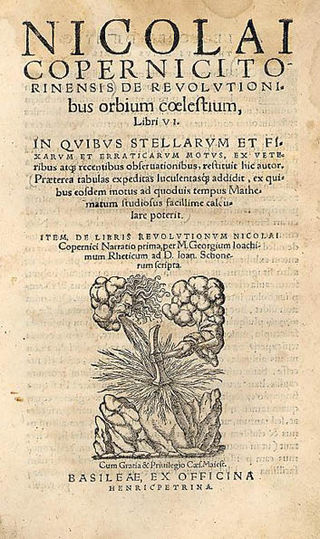Between 1514 and 1529, Copernicus observed the Moon, the Sun, and the planets in order to explain more precisely the pattern of their motions. In this regard he formulated a second, more developed version of his theory. The developed version of his theory is known under the title De revolutionibus orbium coelestium (On the Revolutions of the Heavenly Spheres). The writing of this treatise started not later than in 1515-1516 and ended in June 1542.
 |
| Title page, 2nd edition |
Although De revolutionibus was finished, Copernicus hestitated to publish it. He was strongly supported by his student and friend Georg Rheticus, a young mathematician from Wittenberg. Copernicus finally agreed to publication of more of his main work—in 1542, a treatise on trigonometry, which was taken from the second book of the still unpublished De revolutionibus. Rheticus published it in Copernicus' name. Under strong pressure from Rheticus, and having seen that the first general reception of his work had not been unfavorable, Copernicus finally agreed to give the book tto be delivered to Rheticus in Wittenberg for printing at Nuremberg. De Revolutionibus was published in Nuremberg, just before Copernicus's death, in 1543. The manuscript of this work had been missing, but after 200 years it was found in Prague. Now it is kept in the Jagiellonian Library in Cracow. It is also available on line (here).
De revolutionibus was written in Latin. The book is dedicated to Pope Paul III in a preface that argues that mathematics, not physics, should be the basis for understanding and accepting his new theory. De revolutionibus is divided into six "books" (sections or parts).
The publishing of the book started The Copernican Revolution. You can read more about it here.
De revolutionibus was criticised for being not compatible with Catholic faith. that is why it was placed on the Index of Forbidden Books by a decree of the Sacred Congregation of March 5, 1616 (more than 70 years after Copernicus' publication). De revolutionibus was not formally banned but merely withdrawn from circulation, pending "corrections" that would clarify the theory's status as hypothesis. It remained on the Index until 1835, when Pope Pius VII removed the book from his revised Index. The first Polish translation of the book was made by Jan Baranowski and published in 1854.
| Copernicus in a conversation with Aristotle and Ptolemy (1636) |





Brak komentarzy:
Prześlij komentarz